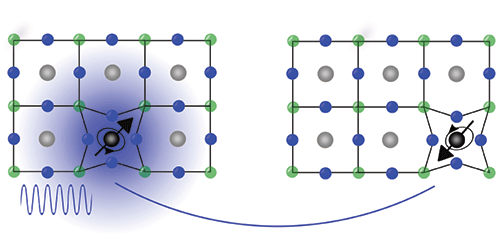Polarons Drive a Magneto-Optical Effect
Data storage, sensing, and waveguiding are just a few of the applications for materials whose response to light changes in a magnetic field. The root of this magneto-optical (MO) effect is usually the material’s own magnetism. Researchers have now found that a surprisingly large MO effect can arise from electrons becoming self-trapped by their distortion of the surrounding crystalline lattice. The concentration of such polaron states in a material can be tuned by strain, so the finding might suggest a route to mechanical or electromechanical control of the MO effect.
Gervasi Herranz from the Institute for Materials Science of Barcelona, Spain, and colleagues focused on thin films of , a so-called manganite known for its “colossal” magnetoresistance. Electrons in form polarons and become less mobile at 265 K, the temperature at which magnetoresistance is highest. The team compared the polarization of a light beam before and after it had reflected from the film. They found that a magnetic-field-induced rotation of the beam’s polarization was more than 10 times greater at 265 K, when the electrons formed polarons, than at higher temperatures, when the electrons were free to move. This field-induced rotation also varied with wavelength from 350 to 750 nm, a range in which polarons are optically active.
Polarons contribute to the MO effect because light excites them to “hop” through the lattice of a solid (changing its optical properties) and the excitation frequency varies in a magnetic field. In most materials, this contribution is small. But Herranz and colleagues argue that it’s enhanced in and possibly other manganites, because of an interaction between the hopping polaron’s spin and its distortion of the lattice.
This research is published in Physical Review Letters.
–Jessica Thomas
Jessica Thomas is the Editor of Physics.





